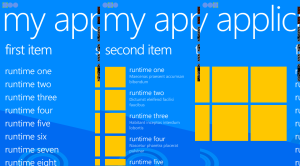I am not sure if this is an known issue for Microsoft, but at least I am aware of this. However this is the first time I am gonna document it. Since it can be very frustrating
The Problem
I want to reorganize the files in my Windows Phone Project in order to follow our implementation of MVVM, moreover we have decided that resx file will live in their own assembly project. However, once I move the Resource file to an external assembly the application just thrown an XamlParseException even though the reference in XAML is totally correct.
REMARKS
XamlParseExceptions may be thrown by other reasons. It is important to realize that I knew I moved the RESX file to a different assembly and before that everything was working. Certainly I updated the reference to the new assembly, and the exception was still being thrown. That is why this is a tricky issue.
The solution
It took some time to me to noticed, but somehow the project that contains the RESX file cannot contain a dot (.) character in its assembly name. If it happens then XAML parse will throw a XamlParserException even though the reference to the assembly is correct. The error message may contain something like this:
System.Windows.Markup.XamlParseException occurred
HResult=-2146233087
Message=Unknown parser error: Scanner 2147500037. [Line: 10 Position: 126]
Source=System.Windows
LineNumber=10
LinePosition=126
StackTrace:
at System.Windows.Application.LoadComponent(Object component, Uri resourceLocator)
at MyApp.App.InitializeComponent()
at MyApp.App..ctor()
InnerException:
Taking a look at the location where I was loading the Resource it was this:
<Application
x:Class="MyApp.App"
xmlns="http://schemas.microsoft.com/winfx/2006/xaml/presentation"
xmlns:x="http://schemas.microsoft.com/winfx/2006/xaml"
xmlns:phone="clr-namespace:Microsoft.Phone.Controls;assembly=Microsoft.Phone"
xmlns:shell="clr-namespace:Microsoft.Phone.Shell;assembly=Microsoft.Phone">
<!--Application Resources-->
<Application.Resources>
<local:LocalizedStrings xmlns:local="clr-namespace:MyApp;assembly=MyApp.WindowsPhone8.Resources" x:Key="LocalizedStrings"/>
</Application.Resources>
<Application.ApplicationLifetimeObjects>
<!--Required object that handles lifetime events for the application-->
<shell:PhoneApplicationService
Launching="Application_Launching" Closing="Application_Closing"
Activated="Application_Activated" Deactivated="Application_Deactivated"/>
</Application.ApplicationLifetimeObjects>
</Application>
The line one of my projects generates an assembly named: ‘MyApp.WindowsPhone8.Resources’, in order to resolve the issue I only have to update the generated assembly name to be ‘MyApp_WindowsPhone8_Resources’ and then update the proper reference in the XAML. For example:
<local:LocalizedStrings xmlns:local="clr-namespace:MyApp;assembly=MyApp_WindowsPhone8_Resources" x:Key="LocalizedStrings"/>
After performing this change your app should work normally.





